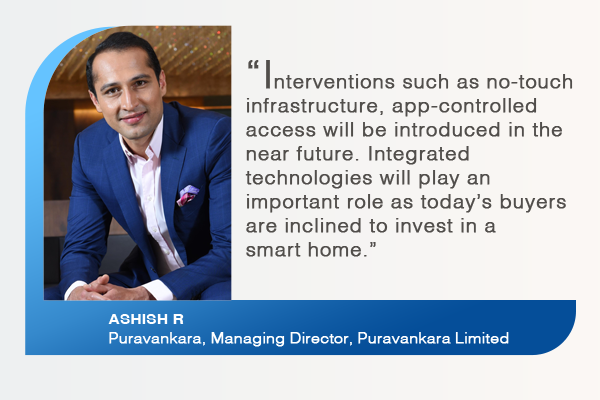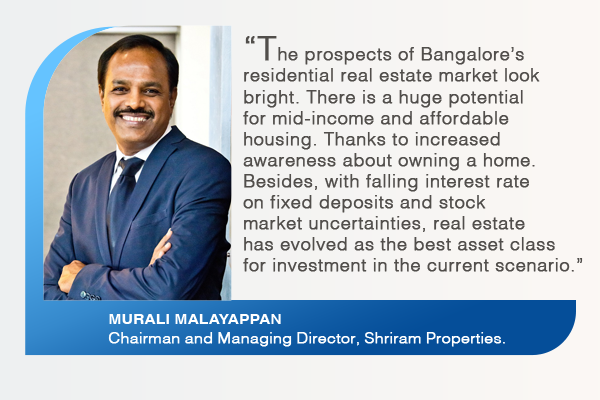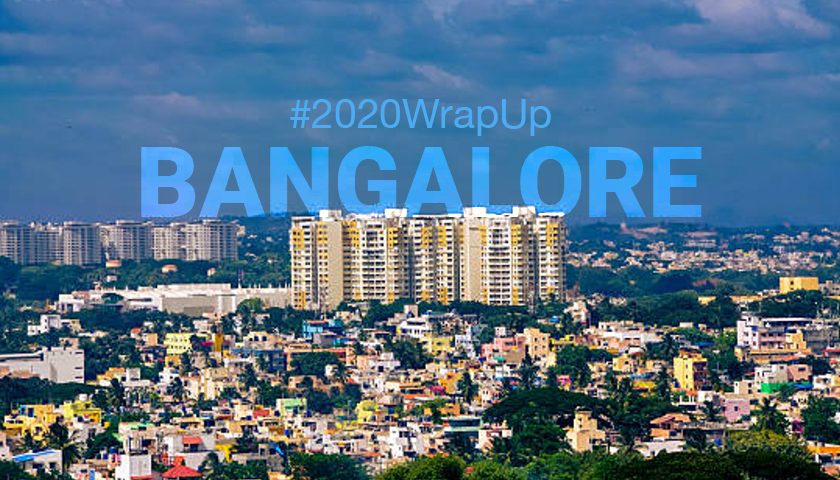Bangalore has been one of the best performing real estate markets in India. For decades now, the city has attracted talent from across the country. Leading as the start-up and tech innovation hub, the city has attracted large corporates and individuals from across the world. The rapid urbanisation clubbed with the quality infrastructure has led to the expansion of the city.
“In the coming quarters, the city will witness several new launches that will be customised to suit today’s working professional. The pandemic has accentuated the importance of owning a home, like never before, and people are now keen to invest in real estate. The number of enquiries has increased drastically since May 2020. This trend will continue over the next year, and the diverse portfolio of Bangalore’s realty market will be able to meet these rising demands,” believes Ashish R. Puravankara, Managing Director, Puravankara Limited.
Crunching numbers
RoofandFloor data reveals that about 1,500 properties were launched in Bangalore this year. Out of the total new supply, 33% was in the mid-segment (Rs 70 Lakh-Rs 1 Crore), followed by 30% in the ultra-luxury segment (Rs 1 Crore and above). Properties in the luxury (Rs 70 Lakh-Rs 1 Crore) and affordable segments (Less than Rs 40 Lakh) recorded 20% and 17% supply respectively.
Micro-markets such as Kanakapura Road, Thannisandra, Budigere Cross, Jalahalli, new airport corridor etc. witnessed launches of affordable and premium affordable projects.
“Better connectivity and proximity to IT parks, hospitals, educational institutions, and shopping complexes have attracted several homebuyers to invest in these markets. Simultaneously, areas such as Whitefield, Electronic City, and Marathahalli also grabbed attention owing to the increasing IT workforce in these areas,” says Ashish.
BHK trends
The pandemic has led to a significant shift in the perception of the homebuyer. People are now keen on investing in larger spaces.
“We have observed a surge in enquires for 2.5 BHK and 3.5 BHK homes, where people are now looking for the extra space that can be converted into a home office or storage space. Several design interventions have been incorporated in projects currently under construction,” explains Ashish.
Additionally, “interventions such as no-touch infrastructure, app-controlled access will be introduced in the near future. Integrated technologies will play an important role as today’s buyers are inclined to invest in a smart home,” he adds.

Localities to watch out for in 2021
Markets in North Bangalore such as Thanisandra, Devannahalli, and other markets falling along the Outer Ring Road are expected to see aggressive development in the coming year. Areas near the airport have several upcoming commercial establishments such as the 400-acre Devannahalli Business Park and the 12,000-acre BIAL IT Investment Region, which makes these localities promising. With the construction of the Metro line in full swing, these regions are expected to yield higher returns.
Unsold inventory
“Bangalore, currently, has about 15-18 months of inventory overhang. This is quite low when compared to other metro cities where it ranges up to 30 to 36 months,” says Murali Malayappan, Chairman and Managing Director, Shriram Properties.
Commenting on this, Ashish presents an interesting perspective. He says, “Some projects that have been completed still await potential buyers creating a stockpile of unsold homes. Developers can help counter this, by constructing responsibly, as per the demand of the area and locality. For example, the demography of a place can help builders decide the audience they want to cater to and the type of project they could undertake. A policy-level intervention could be explored to tackle this if the situation remains unchanged.”
What’s in store for 2021?
Well, “The prospects of Bangalore’s residential real estate market look bright. There is a huge potential for mid-income and affordable housing. Thanks to increased awareness about owning a home. Besides, with falling interest rate on fixed deposits and stock market uncertainties, real estate has evolved as the best asset class for investment in the current scenario,” says Murali.

Going forward, we will witness more innovation in the way projects will be showcased to potential homebuyers. “While 3D walkthroughs, virtual reality and augmented reality have already been implemented in different ways, in the future, we will witness more immersive technologies that will engage the homebuyer and investor, making it easier to make informed decisions without having to visit the project. Developers are now keen to invest in technologies that will aid their business goals, and this will lead to the evolution of con-tech and proptech,” believes Ashish.
The wishlist
The regulatory framework and the systematic implementation of the government reforms have helped the sector regain its momentum. It will further help to rekindle the sentiment of the consumer, thereby boosting the growth of the residential segment in the coming quarters. Apart from this, we are hopeful the sector will witness the following:
Clearance windows: It has been a long-standing request from the real estate sector that the government ensures a single clearance window for all projects. Several projects get stuck due to changes in policies and governments, which leads to a shortage of funds and stalling of projects. Having a single clearance window can enable efficiency in the planning and execution of projects without any hiccups.
Availability of natural resources: With natural sand becoming scarce day by day, builders and developers are finding it extremely difficult to procure natural sand. The practice has led to the depletion of river beds and drastically impacted the ecology of those areas. Awareness is needed to educate people of the impacts of sand mining, and they should also be educated on the alternatives to river sand such as Robo-sand which is produced through crushing and screening.
Skilled labour: The pandemic has made efficiency an important parameter in construction these days. With the restrictions on the workforce, only a well-strategised plan can help developers to make up for the lost time. In this situation, having skilled labour can make a huge impact by helping projects finish in the stipulated timeline. Currently, a major portion of the labour force is unskilled, and this affects a project’s efficiency as this could lead to unanticipated delays in the completion of projects. In 2019, CREDAI collaborated with NSDC to undertake the skill development of 20,000 construction workers. Similar collaborations will be needed to transition the unskilled labour force to become a skilled labour force.

